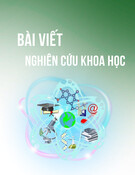
66
U.S. Foreign Aid to Vietnam:
A Fifty-Year Historical Analysis (1975 - 2025).
Nguyen Khoia
a US-Vietnam Research Center, University of Oregon. 1585E, 13th Avenue, Eugene, Oregon, Hoa Kỳ. e-mail:
khoin@uoregon.edu
ISSN: 2815 - 5807
Abstract:
This paper explores the 50-year evolution of U.S. foreign aid to Vietnam following the Vietnam War, from
initial humanitarian relief to economic and technical assistance. It examines the impact of diplomatic
normalization in 1995 and the 2025 cessation of USAID activities. Through analysis of primary documents,
scholarly literature, and media reports, the paper critically assesses the influence of U.S. aid on Vietnam's
reconstruction, economic modernization, and governance reforms, while considering the strategic and
diplomatic underpinnings of the bilateral relationship. The research illuminates how aid modalities adapt to
changing political climates and developmental needs, and highlights the role of soft power in major power
competition.
Keywords: Geometric, Characterization, Extremal Sets, Hemi-Sphere, S∞
Received: 11.04.2025; Accepted: 15.6.2025; Published: 30.6.2025
DOI:10.59907/daujs.4.2.2025.449
Dong A University Journal of Science, Vol. 4, No. 02(14), June 2025, pp. 66-79
©Dong A University, Danang City, Vietnam

67
Introduction
The Vietnam War concluded in 1975, leaving Vietnam devastated, its infrastructure
and economy in ruins. Despite a contentious wartime history, the United States initiated
aid programs to address urgent humanitarian needs and, eventually, support economic
rebuilding. Initially, these efforts were hampered by limited cooperation and ideological
differences due to the war’s legacy and political tensions. The normalization of relations in
1995 marked a turning point, transforming U.S. aid into structured, sustained developmental
assistance driven by both strategic geopolitical interests and a genuine commitment to
post-conflict reconciliation (Vu & Nguyen, 2024).
Understanding the historical progression of U.S. aid to Vietnam is essential for several
reasons. First, it illuminates the role that aid has played in transforming bilateral relations,
shifting from enmity to a pragmatic partnership. Second, it provides insights into how
aid modalities adapt in response to changing political climates and developmental needs.
In addition, by examining the hypothetical cessation of USAID activities in 2025 under
President Donald Trump, the study highlights potential vulnerabilities in the long-term
developmental trajectory of Vietnam and prompts broader discussions on the future of U.S.
foreign assistance. Lastly, this study investigates the role of soft power in the competition
between major powers through the case of Vietnam. Both China and the United States,
the two superpowers vying for power in the 21st century, consider Vietnam a contested
region. Under President Donald Trump, the United States has adopted isolationist policies,
withdrawn from global strategic regions, and dismantled soft power maintenance tools
such as USAID. This has created a vacuum in Vietnam, and Southeast Asia more broadly, for
China to fill. This study seeks to clarify the potential damage to US interests by examining
the role of US aid in promoting these interests in Vietnam, a former enemy.
The evolution of U.S. aid to Vietnam
The issue of US aid to Vietnam following the war’s end in 1975 has not been thoroughly
researched. To date, only a few reports, which are policy advocacy documents rather than
academic studies, provide an overview of this process.
In 2005, the Congressional Research Service (CRS) published the report “Overview
of the U.S. Aid Program in Vietnam,” which outlines the history, structure, and primary
components of American bilateral assistance in Vietnam since 1975, including shifts due
to political, economic, and security considerations. (Congressional Research Service, 2005).
Also in 2005, to commemorate the 10th anniversary of the normalization of relations
between Vietnam and the United States in 1995, the Congressional Research Service (CRS)
published the report “The Vietnam-U.S. Normalization Process” (Mark Manyin), which

68
examines the gradual reestablishment of economic and diplomatic ties between the two
countries, emphasizing how American aid was restored and transformed during the
normalization process beginning in the early 1990s.
CRS Report RL32427 in 2006, “Millennium Challenge Account: Implementation of
a New U.S. Foreign Aid Initiative” provides an overview of US international aid policy,
including a discussion of Vietnam. Although not exclusively focused on Vietnam, this
report discusses aid mechanisms, including those affecting Vietnam, and provides insight
into the design of the new U.S. foreign assistance programs, reflecting broader trends that
impact American aid in Southeast Asia (Mark E. Manyin, 2005).
Official reports from USAID and other U.S. government agencies provide detailed
accounts of aid initiatives, their implementation challenges, and assessments of their
outcomes. These documents show that U.S. aid initiatives for Vietnam in the early postwar
period focused on the humanitarian response immediately after 1975, while U.S. aid policy
initiatives for Vietnam since the normalization of relations in 1995 have shifted attention
to economic and technical assistance (Vu, T. & Nguyen, T., 2022). Simultaneously,
Vietnamese government documents offer a domestic perspective on how these programs
have influenced national development and governance.
The complex relationship between the United States and Vietnam has undergone
a remarkable transformation in the decades since the end of the Vietnam War. From
adversaries, the two countries have gradually forged a cooperative partnership, marked
by robust trade connections and increasing security cooperation. American aid to Vietnam
has been a critical component of this evolving relationship, encompassing humanitarian
assistance, development initiatives, and security collaborations. This literature review
delves into the existing scholarship on American aid to Vietnam since 1975, examining
its historical context, motivations, impact, and Vietnamese perspectives (The Evolution of
U.S.–Vietnam Ties, 2017).
Post-War Isolation
April 18, 1975, just before the war ended, the U.S. Congress passed a series of laws
restricting aid to Indochina. These included the Vietnam Contingency Act of 1975, which
established a fund for humanitarian and withdrawal purposes, and authorized the use
of armed forces to protect the withdrawal of U.S. citizens and their dependents. This act
also mandated that funds be distributed through the United Nations or voluntary relief
agencies (D-AL, 2025). The conclusion of the Vietnam War in 1975 ushered in a period
of profound political and economic upheaval for Vietnam. The country, newly unified
under the Communist Party of Vietnam, confronted international isolation and a faltering

69
economy ( The Asia Pacific Foundation of Canada, 2018). The United States, still grappling
with the aftermath of a divisive war and facing declining Congressional support for
foreign aid. As a result, the US enacted a trade embargo and severed diplomatic relations
with Vietnam. This period of strained relations was further complicated by the unresolved
issue of American prisoners of war (POWs) and those missing in action (MIAs), along with
concerns about human rights in Vietnam (The House of Representatives, 1998).
Path to Normalization
Despite these obstacles, a gradual shift in Vietnamese foreign policy towards greater
independence, combined with Vietnam’s need for economic integration, set the stage for
improved relations with the United States in the 1990s. Vietnam’s efforts to address the
POW/MIA issue and engage in bilateral trade agreements, such as allowing the search for
missing U.S. soldiers, were crucial steps towards the eventual normalization of diplomatic
relations in 1995 (Vu, Tuong and Nguyen, Thuy, 2022). The resumption of U.S. aid to
Vietnam closely followed this trajectory, beginning with a modest $1 million allocated
for prosthetics for Vietnamese war victims in 1991. This initial trickle of aid signaled the
beginning of a new chapter in U.S.-Vietnam relations (Perrin Atreides, 2023).
According to statistics from the United States Census Bureau, in 1992, Vietnam had
no exports to the United States and imported $4.6 million worth of goods from the United
States. The normalization of relations in 1995 marked a turning point. The United States and
Vietnam established embassies and consulates, and trade relations expanded significantly.
In 1995, the United States exported $252.3 million to Vietnam and imported $199
million. In 1997, Vietnam had its first trade surplus with the United States. Vietnam
exported $388.4 million and imported $286.7 million. Vietnam’s trade surplus with the
United States has lasted from 1997 to the present. In 2024, Vietnam’s trade surplus with
the United States is 123.46 billion USD (The US Census Bureau, 2024). The United States
emerged as Vietnam’s largest trading partner. This economic engagement played a crucial
role in fostering closer ties between the two nations.
However, the legacy of the war continued to cast a long shadow. Americans grappled
with the meaning of the conflict and its impact on U.S. foreign policy. The War Powers
Resolution, passed by Congress in 1973 to limit the president’s authority to commit forces
to conflicts without congressional approval, reflected the growing reluctance to engage
in foreign interventions. Despite these challenges, the relationship between the United
States and Vietnam continued to evolve. The rise of China as a regional power created
a convergence of interests, with both countries seeking to maintain stability in the South

70
China Sea. This shared concern has become a driving force behind increased cooperation
and the expansion of American aid to Vietnam.
American Aid to Vietnam: Motivations and Goals
The motivations behind American aid to Vietnam are multifaceted and have evolved
over time. Initially, humanitarian concerns were paramount. The United States provided
assistance to Vietnamese refugees fleeing the conflict and addressed the enduring
consequences of the war, such as unexploded ordnance and the devastating effects of
Agent Orange. Operation Babylift, initiated in 1975, airlifted thousands of Vietnamese
orphans to the United States, highlighting the humanitarian efforts undertaken during the
fall of South Vietnam.
As relations improved, the focus of American aid shifted towards development
assistance. The World Bank’s assistance program in Vietnam, with its objectives of
supporting Vietnam’s transition to a market economy, enhancing equitable and sustainable
development, and promoting good governance, exemplifies this approach. In the first ten
years, from 1993 to 2004, Vietnam received pledges of $29 billion in Official Development
Assistance (ODA), with about $14 billion disbursed. In 2004 alone, international donors
pledged $2.25 billion in ODA, of which $1.65 billion was disbursed (Le, T. 2004).
Furthermore, the United States has increasingly viewed aid as a means to cultivate closer
ties with Vietnam, particularly in the context of regional security concerns (Perrin Atreides,
2023).
The emergence of China as a regional power has led to a convergence of interests
between the United States and Vietnam, with both countries seeking to maintain peace
and stability in the South China Sea. American aid, including security assistance and
military training programs such as IMET (International Military Education and Training),
has become a tool to bolster Vietnam’s defense capabilities and counter Chinese influence
(Kaplan, R. D., 2012).
Types of American Aid to Vietnam
The multifaceted relationship between the United States and Vietnam is reflected in
the diverse range of programs and initiatives encompassed by American aid to Vietnam.
These programs and initiatives, driven by the motivations and goals outlined above, can
be broadly classified into several categories.
First of all, let’s look at US humanitarian aid policy in Vietnam. Humanitarian
aid includes assistance provided to Vietnamese refugees following the war (D-AL, J.




![Chính sách tiếp quản giáo dục Đại học ở miền Nam Việt Nam sau 1975: Từ chỉ đạo đến thực thi [Phân tích chi tiết]](https://cdn.tailieu.vn/images/document/thumbnail/2025/20250804/kimphuong1001/135x160/4571754299722.jpg)





















